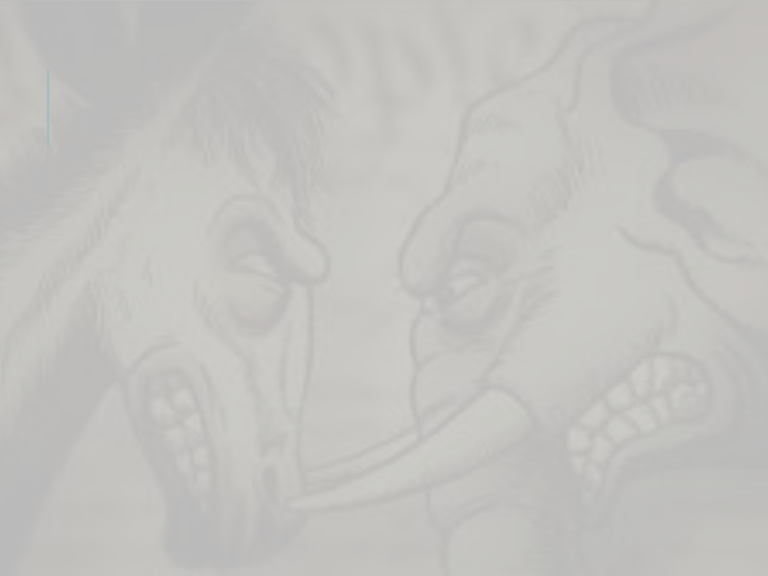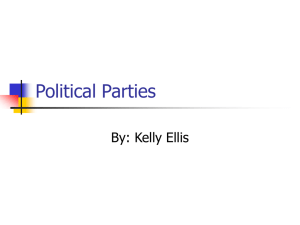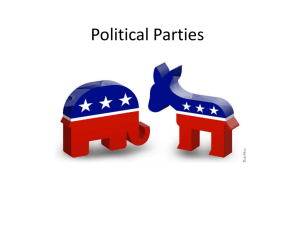A political party - West Ada School District
advertisement

BELL RINGER What did you think about the political ideology tests we have taken? Accurate/inaccurate? What do you think they show you? l___________________l__________________l l___________________l__________________l Social – Where do they go? Liberal Change Gov solves problems Protect social programs Protect environment Pro gun control Anti death penalty More prevention & rehab Pro-choice Pro gay rights Conservative Change Status quo Gov solves problems Small government Individual responsibility Protect social programs Protect economy Protect environment Anti gun control Pro gun control Pro death penalty Anti death penalty Pro-life Pro-choice Oppose gay rights Pro gay rights Status quo Small government Individual responsibility Protect economy Anti gun control Pro death penalty More prisons Pro-life Oppose gay rights Economic– Where do they go? Liberal Restrict econ. freedom Regulate capitalism Tax wealthy money to military Conservative More economic More freedom economic Restrict econ. freedom freedom Regulate capitalism Free Free enterprise enterprise Flat tax Tax wealthy Flat tax money to military money to military money to military BELL RINGER How did your ideology compare to your family members? Do you believe this ideology test was more or less accurate? Why? BELL RINGER 1. 2. What is the political spectrum? Place the following ideas on a political spectrum: Allow more immigrants Maintain the Affordable Care Act Provide free college for all citizens Allow less immigrants The market should determine the cost of college l___________________l__________________l WHAT IS A PARTY? •A political party: group of persons seeking to control government by: •winning elections •holding office •Two major parties in American politics: •Republican •Democrat WHAT DO PARTIES DO? 1. Nominate Candidates – Recruit, choose, and present candidates for public office 2. Inform and Activate Supporters – Campaign, define issues, and criticize other candidates Inform the people Other groups that do this: news media and interest groups WHAT DO PARTIES DO? 3. Insuring good performance Guarantee that candidate is worthy of the office Qualified and of “good character” 4. Govern – Members of government act according to their partisanship firm allegiance to a party Candidate elected = party elected 5. Act as a Watchdog – Parties out of power keep close eye on the actions of the party in power PARTY SYSTEMS Single-Party Systems: One major political party holds power Two-Party Systems: Two major political parties Third parties may exist BUT hardly gain enough support to win Least common system in the world Multiparty Systems: Three or more political parties holding office No party gains control of the government Parties must work together COUNTRY # PARTIES IN OFFICE Vietnam 1 United States 2 Australia 7 Denmark 11 Germany 5 Guatemala 11 Iceland 5 Israel 12 Turkey 4 WHY A TWO-PARTY SYSTEM? The Historical Basis: The nation started out with two-parties Federalists and the Democratic Republicans The Force of Tradition: America has a two-party system because it has always had one Minor parties have never made a successful showing The Electoral System: Certain features of government, such as single-member districts, are designed to favor two major parties Ideological Consensus: Most Americans have a general agreement on fundamental matters BELL RINGER 1. 2. 3. What type of party system exists in the United States? Why has the U.S. had this? What do you think influences which political party a person will be a member of? Explain. PARTY MEMBERSHIP PATTERNS Factors that can influence party membership: Family Major events 2 out of 3 Americans follow the party allegiance of their parents Civil War and the Great Depression are the most significant Economic Status Religion Higher income = Reps Lower income = Dems Religious = Reps Non-religious = Dems Occupation Age Issues that affect your job can sway you to one party or the other Younger (18-35) = Dems Older (45-60) = Reps WHAT DO YOU THINK? Which of the 6 factors do you believe has the largest and smallest impact? Explain in 5 sentences. HISTORY OF U.S. POLITICAL PARTIES THE NATION’S FIRST PARTIES Federalists Demo-Republicans •Led by Alexander Hamilton •Led by Thomas Jefferson •Represented wealthy and upperclass interests •Represented the “common man” •Favored strong executive leadership •Liberal interpretation of the Constitution •Favored Congress as the strongest arm of government •Strict interpretation of the Constitution AMERICAN PARTIES: FOUR MAJOR ERAS The Three Historical Eras The Era of the Democrats, 1800—1860 Democrats dominate all but two presidential elections The Whig Party emerges in 1834, but declines by the 1850s, electing only two Presidents The Republican Party is founded in 1854 The Era of the Republicans, 1860—1932 Republicans dominate all but four presidential elections The Civil War disables the Democratic Party for the remainder of the 1800s The Return of the Democrats, 1932—1968 Democrats dominate all but two presidential elections. Democrat Franklin D. Roosevelt is elected President four times. THE ERA OF DIVIDED GOVERNMENT 1968-Today Neither Republicans nor Democrats have dominated the presidency and Congress has often been controlled by the opposing party. 1968–1976 1976–1980 • Republicans hold the presidency • Congress is controlled by Democrats • Democrats hold the presidency • Congress is controlled by Democrats 1980 1992 1992 2000 2000 2004 • Republicans hold the presidency • Senate controlled by Republicans 1980-1986, controlled by Democrats from 1986 to 1994 • Democrats hold the presidency • Congress controlled by Republicans, 1994 to present • Republicans hold the presidency • Congress is controlled by Republicans MINOR POLITICAL PARTIES MINOR PARTIES IN THE UNITED STATES Types of Minor Parties •Ideological Parties: Based on a set of beliefs – comprehensive view of social, economic, and political matters • Ex. Libertarian, Socialist, Communist, Constitutionalist •Single-issue Parties: concentrate on only one public policy matter • Right to Life, Prohibition Party ,Green Party, U.S. Marijuana Party •Economic Protest Parties: rooted in periods of economic discontent • Greenback Party, Populist Party, Tea Party •Splinter Party: parties that split away from one or other major parties • Bull Moose, Progressive, Dixiecrat WHY MINOR PARTIES ARE IMPORTANT: 1. “Spoiler Role” • Candidates pull decisive votes away from major parties’ candidates 2. Critic • Take stands/draw attention to controversial issues major parties ignore 3. Innovator • Draw attention to important issues and propose innovative solutions to problems • If gain support often integrated into the platforms of the two major parties THE FUTURE OF MAJOR PARTIES For voters : For candidates: 1. Unwilling to label 1. Structural changes themselves as have increased conflict “Democrats” or and disorganization “Republicans” within parties 2. Split-ticket voting = 2. Changes in the voting for candidates technology of of different parties for campaigning have different offices at the made candidates more same election independent of the party 3. The growth of singleissue organizations EXIT TICKET 1. List the 4 types of minor parties 2. What do you need to do for the campaign still?








